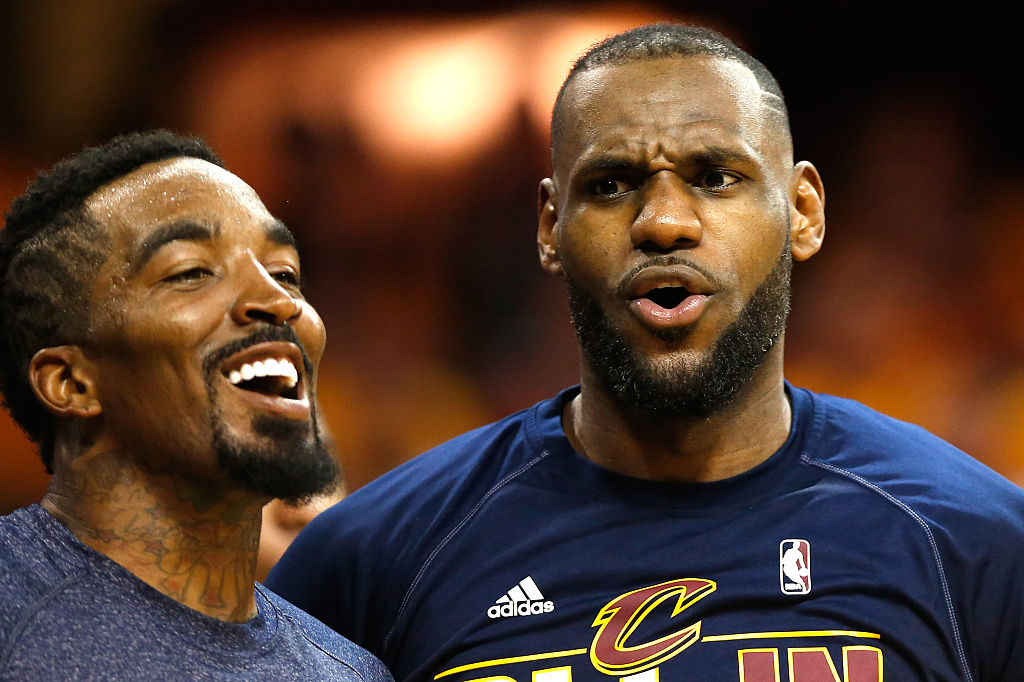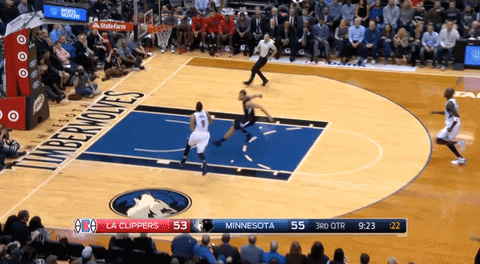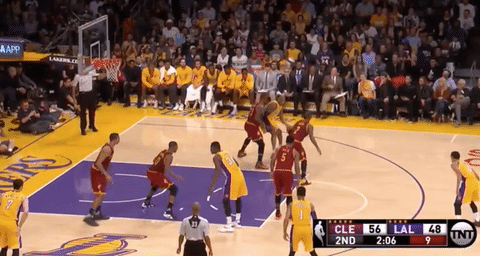Oh, great, you’re probably thinking, another March Madness post. Not quite! We could rank the best players from each team in the tournament, but we decided to take this opportunity to appreciate a dying breed in the NBA: players who never attended college.
It’s important to note that this ranking isn’t comprehensive, nor does it include European players (save for one pseudo-exception) — that would involve way too many players. Instead, we’re looking at the top non-college players still playing in the NBA.
The NBA approved the “one and done” rule for drafting or signing a player in 2005, so it’s been more than ten years since a player had to go to college—or overseas for a year—before joining the NBA. Some of the high-schoolers who went right to the NBA flamed out a long time ago. Others, like Amar’e Stoudemire, are well past their prime. This is a look at the 10 best high schoolers who are still playing in the NBA, but never had that taste of March Madness.
10. Kevin Garnett
If we were looking at Garnett’s entire career, then obviously, he’s much, much higher on the list. However, we’re talking about best players right now, and Garnett is basically a player-coach, with an emphasis on the coach part, at this point. Garnett’s averaging just 14.6 minutes per game, and has appeared in only 38 games this year. Needless to say, his numbers are down across the board. Yet the Timberwolves knew (or, hopefully knew) that they wouldn’t get a prime Garnett, or even a gently-used Garnett, when they brought him back this year.
They need him to be a mentor to their young stars, particularly Karl-Anthony Towns and Andrew Wiggins,constantly in their ears, be it with praise or criticism. The Wolves may not benefit much from KG’s presence on the court, but they certainly benefit from his tutelage on the bench and behind the scenes.
9. Tyson Chandler
Chandler was supposed to be the Suns’ big offseason acquisition, the new anchor to their defense and a veteran presence that would vault them into the playoffs. That…didn’t work out so well. Chandler quickly went from engaged to checked-out, especially once all of the Suns’ other issues (chemistry, Markieff Morris, injuries) all started to rear their ugly heads. He’s shown that, when healthy, he can change the entire complexion of a defense. That Chandler hasn’t been present in Phoenix hardly at all, even with Phoenix’s warlock training staff in the perfect position to keep him healthy. Maybe next year. Then again, maybe there’s no reviving him this time.
8. Al Jefferson
https://www.youtube.com/watch?v=RE9pO-04tWU
It’s been a rough year for Jefferson, who has dealt with suspensions (thanks to the NBA’s archaic marijuana policy) and injuries (torn meniscus). He’s bounced back with every return, though he’s not the player he was two years ago in his first season under Steve Clifford.
Jefferson was the 15th pick by the Boston Celtics out of Prentiss high school in Mississippi in 2004. He was the centerpiece of the Garnett trade, which sent him to Minnesota for the Big Ticket. In both Minnesota and Utah (his last stop before Charlotte), Jefferson put up dominant offensive numbers while playing awful-to-horrid defense. Under Clifford, however, that changed. He wasn’t dominant by any means, but he was at least not-terrible, which is a huge upgrade. Jefferson’s absence this year was supposed to doom the Hornets, but it’s instead allowed them to flourish and player a faster-paced, better-spaced offense. He’ll still get his hits in, but he’s no longer the feature of the team.
7. Brandon Jennings
Here’s the pseudo-exception I mentioned earlier. While Jennings didn’t hop straight from Oak Hill to the NBA, he also didn’t go to college, instead playing for a year in China. Jennings’ rookie year started off with a bang, at one point scoring 55 points in a single game against the Warriors. After that, though, Jennings hit a sophomore slump, and pretty much continued slumping ever since. He was in the midst of a career renaissance last season under Stan Van Gundy, but a torn achilles derailed that campaign.
The Pistons then shipped Jennings to the Magic, reuniting him with his old coach, Scott Skiles, a reunion that has yet to really produce any tangible benefit.
6. Kobe Bryant
Funny how I almost left Kobe off this list entirely. It just seems as if Kobe never played anywhere else except in the NBA, as if he was born a 6-6 NBA ready guard straight from the womb. The spectacle of Kobe’s farewell tour has distracted from the fact that Kobe simply hasn’t been good this year (or, really, the past few years). He’s picked it up a bit in the back-half of the season —at least, when he plays — but he’s still not the top-flight guard he once was. Nevertheless, he’ll go down in history as one of the best to ever jump straight to the pros from high school.
5. J.R. Smith
https://www.youtube.com/watch?v=SbxSafSVY9Q
Smith, drafted by the New Orleans Hornets in the 2004 NBA draft, was among the last of the preps-to-pros generation. He had all the talent in the world, but struggled with consistency and attitude issues. Those issues have plagued Smith for his entire career, from New Orleans to Denver to New York and even in Cleveland, where one would think there’s nothing to potentially distract Smith.
When Smith is on, he’s not just hot, he’s burning with the intensity of a supernova star. When he’s cold, however, he’s right at home with penguins in Antarctica (he also has the uncanny ability to go from scorching to arctic in mere seconds). Smith is low-key one of the most intriguing “what-if” players — what if he’d learned to harness his skills with a focused mind? Would we still be talking to him as a not-so-lovable clown, or one of the best two-guards to play the game?
4. Monta Ellis
“Have It All” came dangerously close to not having anything. He committed to Mississippi State, then decided to declare for the draft instead. He was taken in the second round by the Golden State Warriors, and though at first he struggled to get any playing time, he later evolved into the team’s franchise player (at least for a while). I’ll always remember when Don Nelson finally gave Ellis some time in a meaningless blow out towards the end of the season, seeing Ellis burn every defender who tried to stay in front of him with his blinding speed. That speed was the foundation of Ellis’ rise to stardom.
Ellis is still the same player on the Pacers as he was on the Warriors and Mavericks. His shot selection is questionable, he can pound the air out of the ball, and his defense isn’t always up to snuff. But, dammit, he’s a fun player, and a very good one who still never quite gets his due. He can still put up 30 when he needs to, and can still frustrate fans one moment then delight them the very next.
3. Shaun Livingston
https://vine.co/v/OVrun3BLQtv
No, don’t worry, we won’t put the video here. Whereas Ellis has essentially remained the same player throughout his entire NBA career, Livingston has gone through several transformations during his tenure. These transformations were necessary due to Livingston’s gruesome injury. First he was the point guard of the future for the Clippers, a tall, lanky project with remarkable vision and speed and a broken jump shot. After the injury, Livingston struggled to find his way. He was the stereotypical journeyman trying to stick in the league, but couldn’t quite find a home.
Livingston’s third reinvention, which started when he signed with the Nets, is the one that finally saw him find his place in the league. He became a non-traditional point guard, still using his vision, but playing mostly from the elbows or in the post, where he can execute a deadly turnaround jumper. So what if Livingston didn’t turn out to be the Next Big Thing at point guard. He’s found a home with the Warriors, doing so while making a remarkable recovery from an injury that could have derailed his dreams forever.
2. Dwight Howard
https://vine.co/v/iHe7weYeni2
I’ve already written quite a bit on Howard this season, but even though he’s in decline, he’ll still go down as one of the best straight-to-the-NBA players of the 2000s, maybe even of all time. The Rockets are having a dreadful season, but they’re still in the playoffs thanks in no small part to Howard’s heroics.
When he’s fully healthy, he’s still a dominant force on defense and an impossible task on offense. He’s not at his peak as often as he used to be, but he’s still capable of reaching it. If he decides to move on next season, the impact that will have on the Rockets’ defense will be quite visible from day one of the next year.
1. LeBron James
We all knew where this was heading. It’s not even a contest. LeBron James is, without a single shred of doubt, the best prep-to-pro player in the NBA. He might even be the best of all-time. There’s really not much more to say than that.









